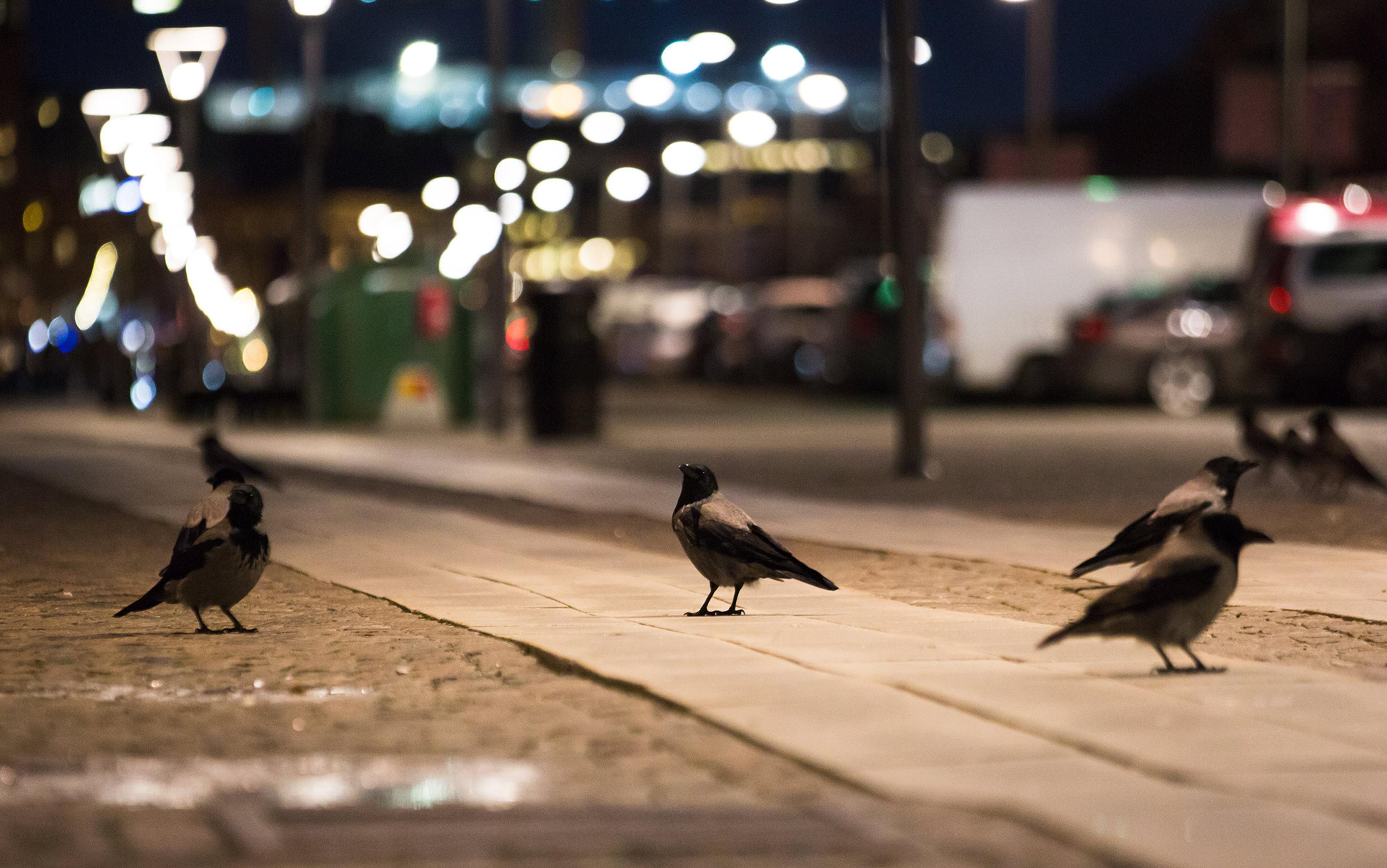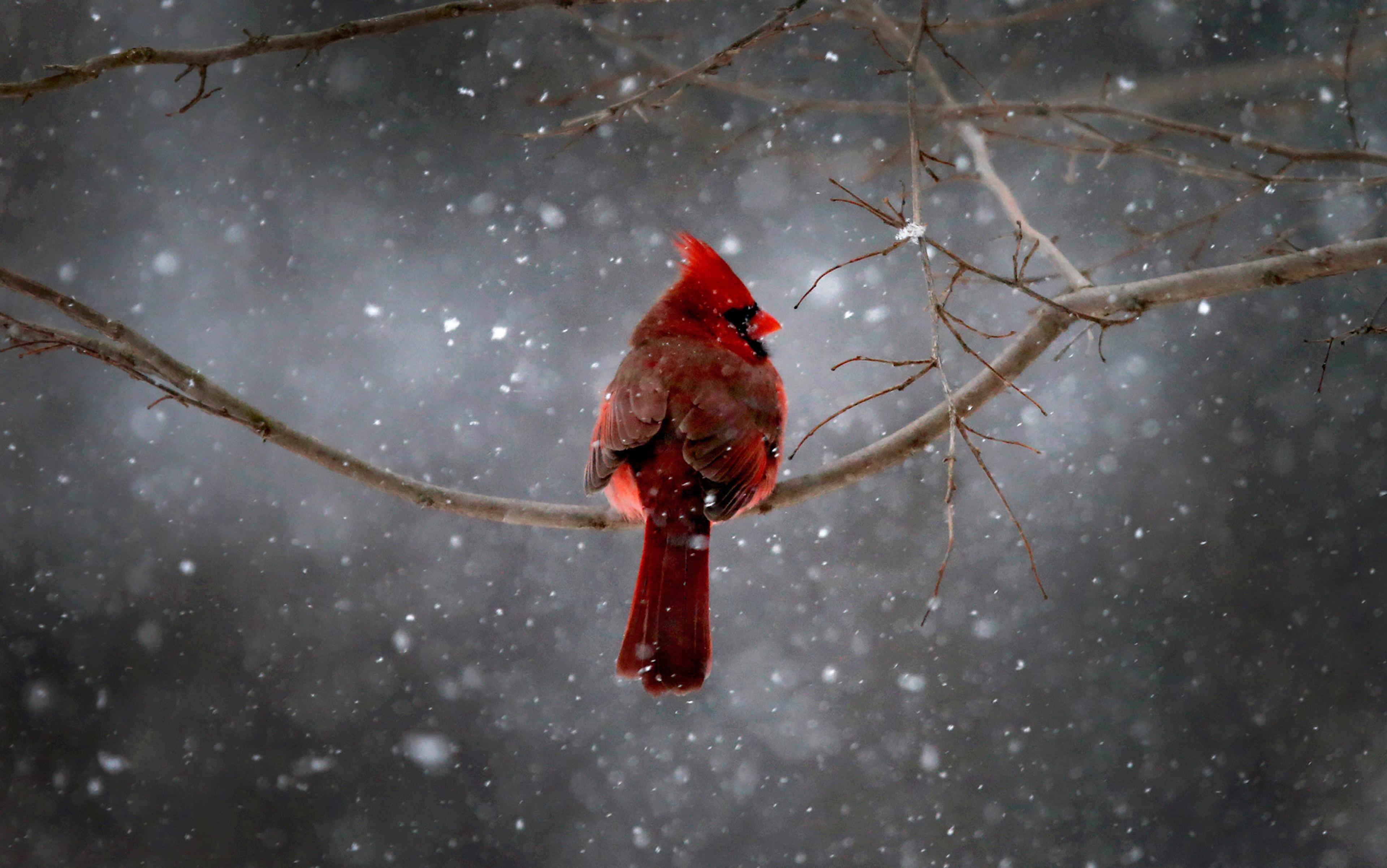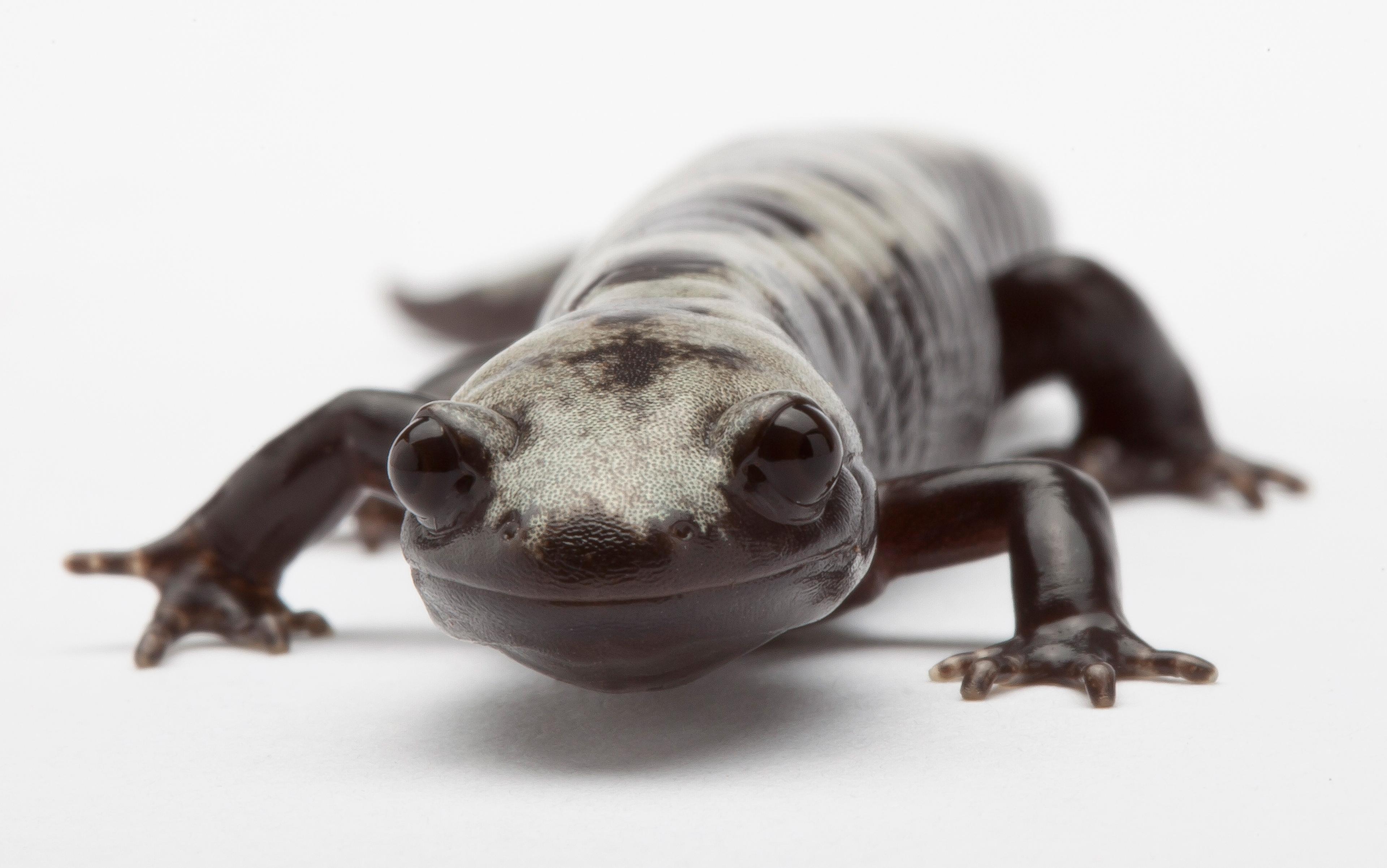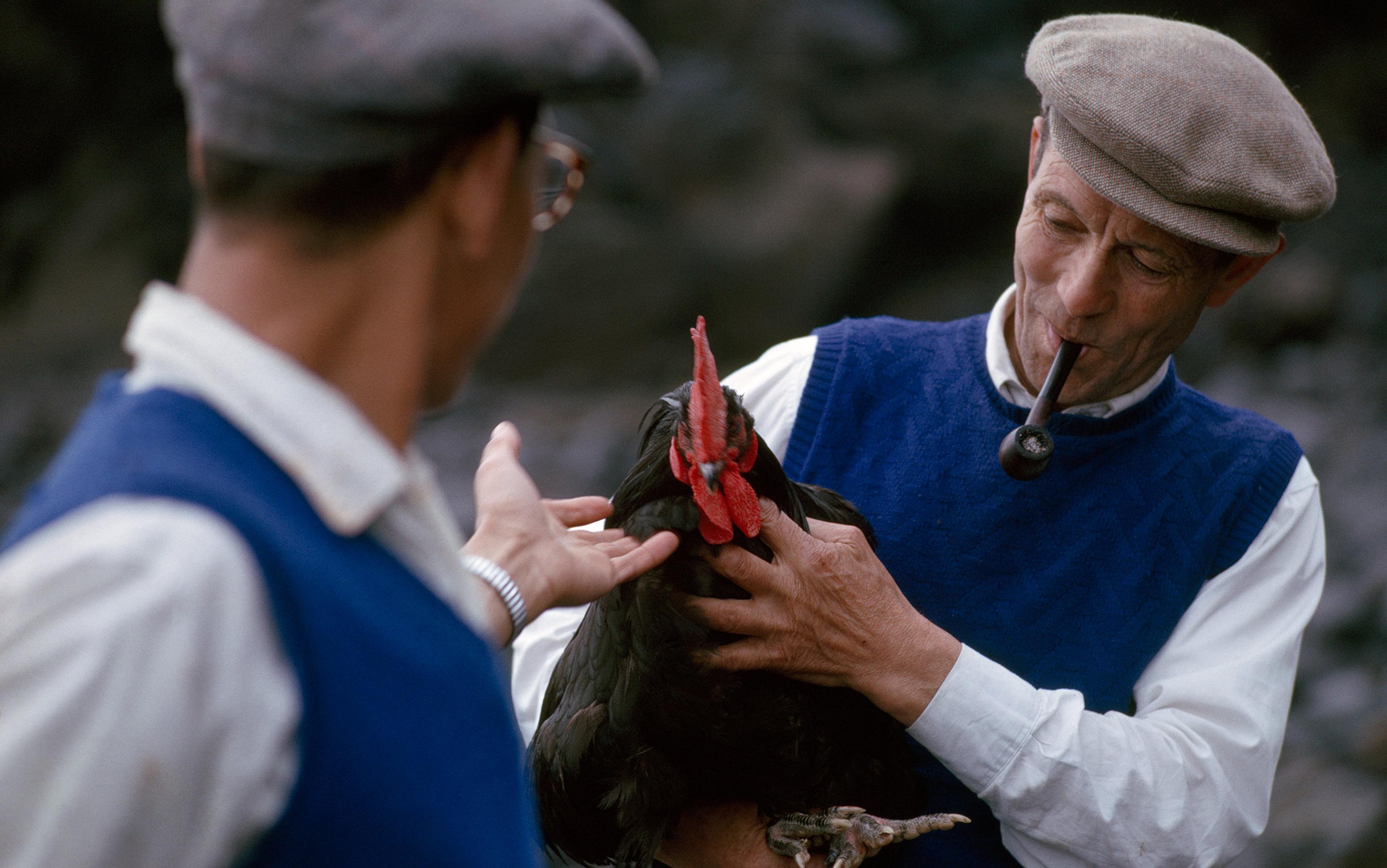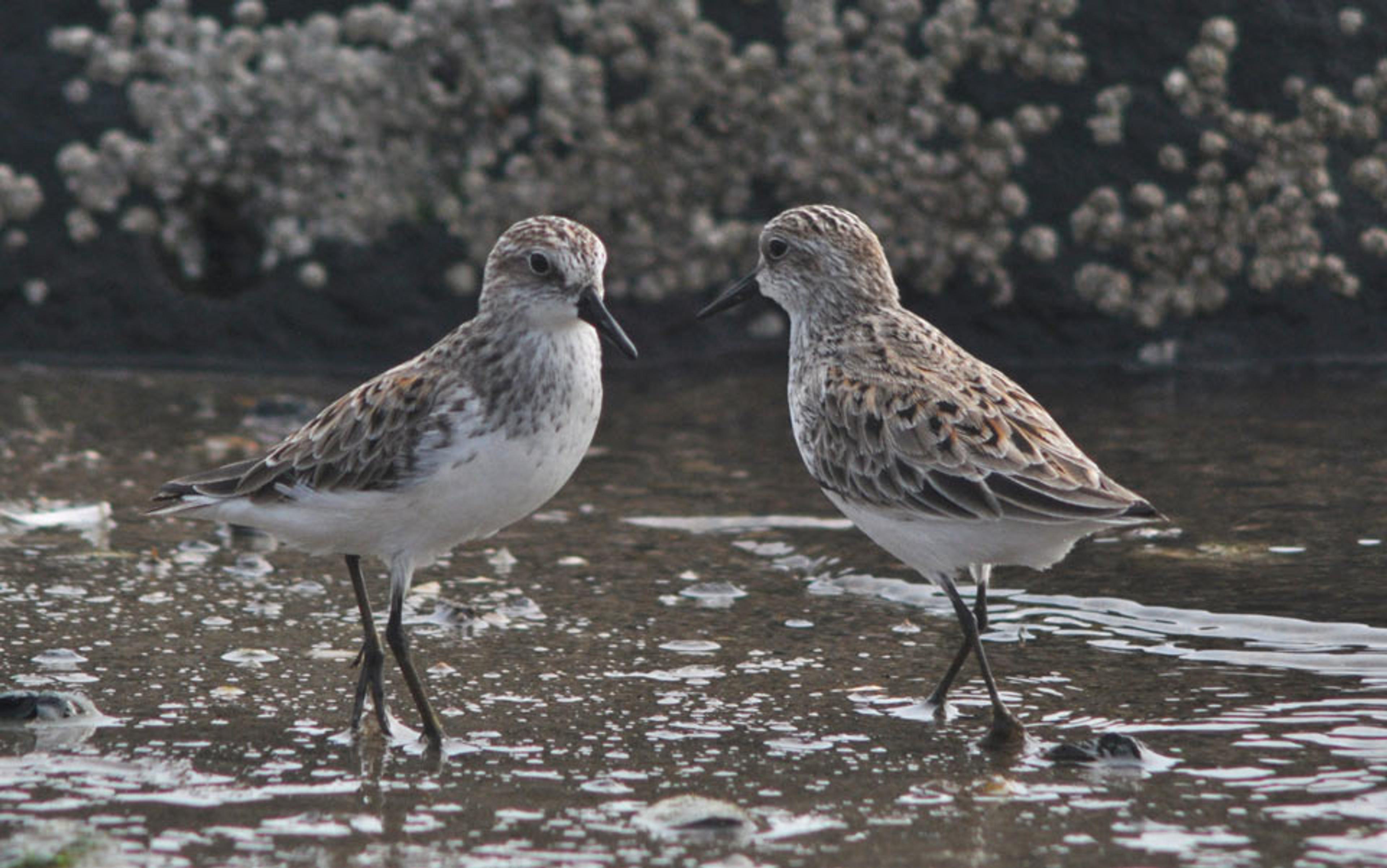A crumbling concrete wall, a ramp and a vast expanse of asphalt on which identical silvery-grey sedans are slowly circling and zigzagging between traffic cones. It does not seem like much but, to urban biologists, the Kadan driving school in the Japanese city of Sendai is hallowed ground. The four of us (the biology students Minoru Chiba and Yawara Takeda, the biologist Iva Njunjić, and I) have been sitting on that crumbling wall for several hours now, hoping to observe what this place is famous for.
It was here that, in 1975, the local carrion crows (Corvus corone) discovered how to use cars as nutcrackers. The crows have a predilection for the Japanese walnut (Juglans ailantifolia) that grows abundantly in the city. The pretty nuts (a bit smaller than commercial walnuts, and with a handsome heart-shaped interior) are too tough for the crows to crack with their beaks, so for time immemorial they have been dropping them from the air onto rocks to open them. Everywhere in the city, you find parking lots strewn with the empty nutshells: the crows either drop them in flight or carry them to the tops of adjoining buildings and then throw them over the edge onto the asphalt below.
But all this flying up and down is tiring, and sometimes the nuts need to be dropped repeatedly before they split. So, at some point, these crows came up with a better idea. They would drop nuts among the wheels of slow-driving cars, and pick up the flesh after the car had passed. The behaviour started at the Kadan driving school, where there are plenty of slow-moving cars, was copied by other crows, and so spread to other places in the city where slow-moving giant nutcrackers were common, such as near sharp bends in the road, and at intersections. At such places, rather than dropping the nuts from above, the crows would station themselves by the roadside and place them more accurately on the road. Since then, the fad has also turned up in other cities in Japan.
In 1995, the zoologist Yoshiaki Nihei then at Tohoku University in Sendai made a detailed study of the behaviour. He observed how the crows would wait near a traffic light, wait for it to turn red, then step in front of the cars, place their nuts, and hop back to the curb to wait for the light to change. When the traffic had passed, they would return to the road to retrieve their quarry. His work revealed the crows’ finesse in handling their ‘tool’. For example, the birds would sometimes move a walnut a few centimetres if it took too long for it to be hit by a wheel. In one case, he even saw how a crow would walk into the path of an oncoming car, forcing it to brake, and then quickly toss a nut in front of its wheels.
These fascinating observations languished in relatively obscure Japanese scientific papers until 1997. That year, the BBC came to Sendai to film the crows for David Attenborough’s series The Life of Birds. His voice-over made them an instant hit: ‘They station themselves at pedestrian crossings … Wait for the lights to stop the traffic. Then, collect your cracked nut in safety!’
So, finding ourselves in this city with its famous urban crows, our merry band devote the day to viewing them for ourselves. Minoru and Yawara tell us that the crows’ trick is well-known in town. In fact, it is a favourite pastime to throw the crows nuts and watch them perform. So, with a bag of walnuts brought all the way from the Netherlands, we try our luck. But the crows are not cooperating. We have already spent the whole morning at traffic lights at intersections, stupidly waiting on canvas folding chairs at the mercy of the surprised stares of endless motorists but, so far, in vain. And we have now ended up at the reputed epicentre, the Kadan driving school. It is getting hot, and we’re hungry and tired. With glazed-over eyes, we stare at the heaps of nuts we have laid out at various positions on the school’s test range. The school’s students carefully avoid them, and the crows fly over without even looking down. This is what urban fieldwork is like.
Perhaps, Minoru and Yawara finally admit, it is too early in the year. The nuts are not ripe yet, the young birds have just fledged, and groups of crows are marauding the city to feast on other things, such as the ripe mulberries that are in abundance everywhere. I sigh and stare a bit more. Then, I hear a cracking noise behind me. I turn around to see that Iva has begun eating our stock of walnuts. She looks at me defiantly: ‘What? They’re not going to come anyway!’
Carrion crows do not occur only in Japan. They also exist in western Europe, where you can similarly find plenty of cars, pedestrian crossings and walnuts. And yet carrion crows in Europe somehow never learnt to exploit human automobile traffic in the Rube-Goldbergian way that they do in Japan.
That is not to say that humans in Europe are safe from having their behaviour manipulated by birds, as demonstrated to us for nearly a century by the famous (and annoying) milk bottletop-opening skills of tits – lively songbirds with a handsome pattern of yellow, black and blue (the blue tit, Cyanistes caeruleus), and olive-green (the great tit, Parus major).
Tits – in fact, all birds – cannot digest milk. Unlike mammals, they lack the enzymes needed to break down the lactose. But the layer of cream that collects at the top of old-fashioned, unhomogenised milk contains very little lactose, and a hungry bird in winter could do worse than supplement its fat intake with a bit of rich cream snatched from the neck of a milk bottle. And that is exactly what tits had been doing for a while in the late-19th and early 20th century in England and elsewhere in Europe, when milkmen were still in the habit of leaving open bottles of milk on people’s doorsteps in the morning. Before the resident mammal would have time to open the door and bring the bottles into safety, a tit would swoop in, land on the neck of a bottle, and dip its beak in the cream inside, consuming up to an inch of the coveted food.
Unfortunately, the very first stages of the ensuing game of attrition between human and bird are lost in the mists of time. Presumably, it was a matter of racing to the front door as soon as the milkman’s cart was spotted, not to give the tits a chance to steal any cream. Tits, not to be outdone, would be hanging out near people’s doorsteps at milk-delivery time to try to get there first. In any case, at some point in the early 20th century, milk suppliers began closing their bottles with wax-board tops. This gave only momentary respite because in 1921, in Southampton, tits began prying these off, or stripping away the cardboard, layer by layer, until the cap was thin enough to be pierced by the bird’s sharp beak.
Changing the cardboard caps to aluminium ones did not help for long either: by 1930, tits in 10 different towns all over England had learned how to open the metal-topped bottles. When faced with a metal cap, they would hammer a hole in it, and then pull away the foil in strips. They might also pull off the entire cap and fly away, holding it in one claw and, in a secluded spot, peck at the cream sticking on the inside of the cap. Under the birds’ favourite tree, the cleaned and discarded caps would gradually pile up to a respectable refuse heap.
But sometimes their greed was their downfall. Robert Hinde and James Fisher, two English ornithologists who studied the behaviour, say that, more than once, blue tits would be found ‘drowned head first in the bottle, presumably because they tried to drink too deep and lost their balance’. Hinde and Fisher learned all this in 1947 because, in a citizen science project avant la lettre, they sent hundreds of questionnaires to birdwatchers, naturalists, milkmen and milk-consuming home-owners, but also to doctors and other ‘people with a scientific training’. Using the replies they received, they were able to piece together a detailed history of the epidemic-like spread of milk bottle-attack skills among tits, and the human countermeasures, all over the British Isles and, in a Europe-wide follow-up questionnaire, also on the Continent.
As the milkman ran back to his cart, other tits would befall on the bottles just delivered
In an article in British Birds in 1949, they published snippets of some of the responses they got, and these betray the depth of the frustration felt by humans in this battle of wits with their mouse-sized opponents. People were exasperated at how quickly the tits were at their milk bottles, often within minutes of the milkman placing them there. As if the birds were waiting for it! (They probably were, since one milkman complained that some tits did not even wait for him to deliver the bottles to a home, but rather raided his cart while he was out placing bottles on somebody’s doorstep. And then as he ran back to his cart, other tits would befall on the bottles just delivered.) In one particularly wholesale onslaught, a gang of tits managed to open 57 of 300 bottles left at a school before the schoolmaster had a chance to chase them off. In some areas, people would provide their milkmen with heavy metal lids, rocks or cloths to leave on top of the bottles, but invariably the tits would learn how to remove those as well.
The maps that Hinde and Fisher published in their article show how the birds’ bottle-opening skills spread. Intriguingly, they did not spread out gradually from the source of the birds’ innovation in Southampton. Rather, tits attacking bottles seemed to pop up independently in many towns and cities, and from there the behaviour would catch on locally. Individual tits rarely move more than 10 or 20 kilometres in a year, and yet new towns more than 20 kilometres away from the nearest affected town would suddenly also be afflicted by cream-hungry tits. So, it is more likely that the behaviour was invented independently by multiple, particularly clever birds that were then imitated by others. For example, in the Welsh town of Llanelli, hundreds of kilometres away from the nearest knowledgeable tit, only one home in a neighbourhood of 300 houses suffered from a single thieving tit in 1939. Seven years later, all the tits in this neighbourhood were doing it. And in Amsterdam, the ornithologist Niko Tinbergen saw great tits opening milk bottles both before and after the Second World War, even though during the war, and in the lean years immediately afterwards, milk was not delivered and no pre-war tits would have survived to 1947, when milkmen gradually began doing their rounds again.
Over the past few decades, the tits seem to have finally been defeated by their milk-guzzling human adversaries. First, skimmed and homogenised milk, which lack the cream on top, became more popular. For a while, the tits managed to circumvent these by learning the cap colour denoting old-fashioned fatty milk. But since then, aluminium-capped glass milk bottles have slowly been replaced by other containers, and the travelling milkmen themselves have all but disappeared, in favour of the supermarket. Today, very few home-owners still know the infuriating feeling of finding their milk vandalised by neighbourhood birds.
This ongoing battle between birds and bottles keeps inspiring urban biologists, because many mysteries remain. How did the bottle-opening skills pass from bird to bird? Are city birds perhaps better or quicker at learning such new tricks or acquiring new tastes than rural birds? And, if so, why?
The answer to that first question – how a new trick learned by one clever bird is passed on to others – was recently revealed by an Australian researcher, Lucy Aplin, working at the University of Oxford. Aplin’s research takes place in Wytham Woods near Oxford. She set up automated computerised ‘puzzle boxes’ all over the forest. A puzzle box is the biologist’s devious way to assess an animal’s problem-solving skills. It is usually a contraption that requires a certain set of actions before it releases a reward in the form of a tasty morsel of food. In the case of Aplin’s tits, the puzzle box consisted of a plastic chest with a stick to perch on. Right by that perch was a door that a bird could slide either to the right or to the left by pushing it with its beak. Behind that door, it would find a dish with delicious live mealworms.
And that was not all. Being next door to a dense cluster of restless biologists, the great tits of Wytham Woods are an intensively scrutinised group of birds. Each, for example, has been fitted with a minuscule transponder chip in a leg ring. By placing antennae at nest boxes and feeding tables, researchers can keep track of the personal history of each bird: how old is it; with whom had it built a nest; but also: who are its friends; with which other tits does it like to hang out? These individual identification codes were picked up by an antenna hidden in the perch on Aplin’s puzzle box each time a bird landed. Switches in the plastic door would register if the bird managed to open it, and – a crucial point, as we shall see – it detected the manner employed: by pushing it left or by pushing it right.
Wytham Woods, at least as far as its great tits are concerned, is divided into eight sections, each harbouring about 100 tits, which interact more with one another than with birds from the other sections. The Oxford tit-watchers call those sections ‘sub-populations’. In each of the five sub-populations, Aplin caught two male birds that were given the honour of being the puzzle boxes’ early adopters: she taught these 10 birds how to open the puzzle box by letting them watch captive birds that already knew the trick. Some she trained to open the door to the right, others to the left, and she made sure that the two birds from the same sub-population learned the same version of the puzzle (either both pushing left or both pushing right).
Aplin could watch the meme spread throughout the birds’ social network until nearly everyone knew about it
The enlightened birds were then released back into their native sub-population to proselytise the puzzle-box gospel, while Aplin set up a battery of puzzle boxes, stocked with mealworms, all over the forest. For four weeks, the circuits of switches, antennas and digital hardware in the puzzle boxes whirred away, constantly recording the comings and goings of birds and the left- or rightward sliding of the door. When the feast was over, Aplin packed up her puzzle boxes, downloaded all the accumulated data and began analysing. She discovered that the majority of the tits, in the five sub-populations where she had released the puzzle-box savvy birds, had learned how to open the door. But in the subpopulations without any ‘trainer’, only very few birds figured out how to deal with the boxes – less than 10 per cent in one case.
It was also clear that this knowledge passed through the subpopulation via networks of friends: the best pals of the ones who had been trained were the first to pick up and then pass on the new knowledge. Since the set-up recorded the exact moment at which each individual bird learned the trick, Aplin could actually watch the meme spread throughout the birds’ social network until nearly everyone knew about it. And this is where the two alternative right-pushing and left-pushing door-opening solutions came in handy: in each sub-population, a tradition of door-opening took hold that depended on how the original trainers had been trained. If they had learned to slide the door to the right, that was how all tits in their sub-population eventually did it, and vice versa. Even a year later, Aplin found, this local box-opening custom was still there.
What the great tits of Britain show is that some animals can learn how to crack human code, and then let their best friends in on the secret – at least until humans come up with a countermeasure. That’s how humans and city-dwelling animals are constantly at loggerheads, but for such information to be learned and passed on among animals, certain faculties are essential. First, the animals need to have a kind of problem-solving intelligence; the kind that helped blue and great tits understand that breaching an aluminium top on a bottle would give access to delightful cream underneath. Secondly, they need to have neophilia – an attraction to unknown objects; when the first glass milk bottles arrived, some tits were not freaked out by them, but instead began exploring them for possible nutritional benefits. And, finally, they need to be tolerant of angry milkmen, tea-cloth-wielding home-owners, and close proximity to people in general.
Clearly, the tits that successfully attacked milk bottles, or Aplin’s puzzle boxes, benefited from the fact that they were tolerant, problem-solving neophiles. But this is not always the case. Under more natural circumstances, it is often safer to be shy, conservative and neophobic. In an environment that has been stable for a long time, humans and other large animals are better avoided since they can be dangerous – objects made by humans tend to have lethal moving parts, so better to be safe than sorry.
But in cities, traditional behavioural adagios might need to be reconsidered. Humans bring in their wake a superabundance of food, they create shelter and nesting sites, and generally offer new opportunities. Moreover, at least in cities, humans tend to be favourably disposed towards most small birds and mammals, and not likely to harm them (though their pets might). Finally, humans are forever creating new stuff. Sometimes, like the McFlurry ice-cream cups that hedgehogs get their spiny heads stuck into, these new objects are dangerous, but often (think milk bottles) the advantages outweigh the hazards.
In other words, we might expect that city animals evolve to become better at exploiting their human neighbours. Not because some gene for opening bottle tops spreads in the population (surely no such gene exists), but because genetic tendencies to be tolerant and more inquisitive (and such genes do exist) will help an animal to quickly learn how to take advantage of humans and their ever-changing ways. By enabling quicker learning, such genes will spread – and the species will evolve in the city to be a more street-smart version of its former rural, stuffy self.
There’s actually evidence that this is the case – that city animals are fearless problem-solvers with a penchant for anything new. Some of this evidence comes from the island-state of Barbados, where McGill University in Montreal, Canada, owns a field centre. Located on the fringe of the city of Bridgetown, generations of McGill staff and students have done their field teaching and graduate research projects there. The field centre has a perfectly fine canteen, but – hey! – it’s on the sandy, sunny Caribbean coast, and the lavish Colony Club is right next door, so quite a few hours of pre- and after-fieldwork lounging are spent there. It was at the Colony Club’s immaculately decked-out tables in 2000 that a few McGill biologists first noticed how cheeky Barbados bullfinches (Loxigilla barbadensis) deftly opened the paper sachets of sugar intended for human consumption. Pretty much like the British blue tits on milk bottles, a bullfinch would hold a sachet with one claw and use its heavy beak to pierce the paper wrapper and gobble up a few mouthfuls of sugar before flying off. Later, the bullfinches were seen mastering other restaurant table manners, such as opening sugar bowls (by turning over the heavy ceramic lids with their beaks) or stealing coffee creamer. ‘When you sit at a terrace in Barbados, it’s almost guaranteed that you will share your table with bullfinches,’ says graduate student Jean-Nicolas Audet.
For Audet and his colleague Simon Ducatez at the University of Sydney, studying these bullfinch behaviours provided the badly needed justification for spending extended periods at the restaurant tables of the Colony Club. Eventually they even managed to persuade their supervisor to let them conduct part of their ‘field’ work at the club. And also at the nearby Coral Reef Club. And the sumptuous Royal Pavilion. But Barbados is not all city and coastal resorts. Although densely populated (on average, nearly 700 people per square kilometre) and heavily urbanised, the northeast corner of the island is still rural. So Audet figured it might be interesting to see if the problem-solving skills of rural bullfinches matched those of the urban ones.
To study this, he devised two types of puzzle box. Both were made of transparent plastic and contained seeds as a reward, but one (the ‘drawer’ box) could be opened either by tugging on a drawer or by pulling off a lid, while the other type (the ‘tunnel’ box) required both actions: first tugging, then pulling. Audet caught 26 urban bullfinches and 27 rural ones and, in the field centre, tested if (and, if so, how quickly) they figured out the puzzle boxes. As it turned out, all birds managed the drawer box, but the urban birds were twice as quick as the rural ones. The more complicated tunnel box was solved by only 13 of the urban bullfinches – but the rural ones did even worse: only seven of those figured it out, and it took them on average nearly three times as long as the city birds.
In the cities, the reverse took place: birds actually flocked to the pimped-up feeding tables
Clearly, urban bullfinches will be better at coming up with new ways of accessing human-provided food. Whether the urban finches actually carry different genes for problem-solving skills from the rural ones is up for debate. Audet suspects that the island might be too small for that, and the birds too peripatetic. Then again, if the benefits are great enough, natural selection can still go against the stream, as it were, and slowly build up genetic differences.
Problem-solving was key trait number one. But for an animal to even approach a problem to be solved, it needs to be less than circumspect about new and unfamiliar objects in its environment. Preferably, it needs to be neophilic: keen to approach and investigate anything that is out of the ordinary. In other words, it needs to be curious.
Over the years, experimental biologists have had a field day (literally) devising experiments to test urban animals’ neophilia. What is more fun than cobbling together weird and wonderful objects that don’t look like anything, and confronting unsuspecting experimental animals with them? It’s like candid camera for biologists. In the name of urban behavioural biology, common mynas in Australia have been exposed to green hair brushes and yellow rolls of tape, English crows to works of modern art pieced together from crisp bags, jam jars and polystyrene fastfood containers, and chickadees in Tennessee to wonderful towers made from Duplo blocks. And in virtually all cases, urban birds approached these weird objects quicker and with more interest than wary rural birds.
One particularly thorough study is worth mentioning here. Piotr Tryjanowski at the Poznán University of Life Sciences and colleagues studied 160 bird-feeders in and around Polish cities. Half of the feeders they adorned with an object ‘brightly green and made out of gum with a tuft of hair’. ‘We never observed anything even vaguely similar in the field making it highly unlikely that local birds responded to this object as anything but a novel object,’ they write in their Scientific Reports article in 2016. Other feeders were left unmodified. Lo and behold, for the four bird species that visited the feeders most (great tit, blue tit, greenfinch, and tree sparrow), the rural visitors were neophobic: they avoided bird-feeders with the weird green thing on the roof, whereas in the cities, the reverse took place: here, birds actually flocked to the pimped-up feeding tables.
After problem-solving and neophilia, the third and final personality trait that the urban environment will select for is tolerance: a reduced fear of humans. In a 2016 article in Frontiers in Ecology and Evolution, a team led by Matthew Symonds of Deakin University in Australia compared 42 different bird species for their so-called flight-initiation distance (FID), or the average distance a human needs to approach a bird before it takes off. They found that, across all these bird species, the urban version was more tolerant than the one from the countryside. Not only that, but the difference was greater the longer the birds had been residing in cities. For example, jackdaws (Corvus monedula) in cities (which they had already colonised by the 1880s) get spooked only if humans come closer than 8 metres, whereas in rural areas they will take off at 30 metres distance. Great spotted woodpeckers (Dendrocopos major), on the other hand, urbanised only since the 1970s, still have similar FIDs in the city and the countryside: 8 and 12 metres, respectively.
This shows that tolerance has actually evolved. It is unlikely that over time, wariness would wane by each bird generation learning to be a tad less careful around people than their parents were – you would expect this to happen more quickly. Rather, if there is a benefit to being more tolerant, genes for tolerance can gradually accumulate, and the species’ personality will evolve. Such an explanation is particularly likely, since the same researchers also found that a bird’s tolerance has nothing to do with the size of its brain: brainy birds did not become tolerant of humans more quickly than, well, bird-brained birds.
It seems likely that problem-solving, neophilia and tolerance are all prone to urban evolution, and in a continual arms race with urban humans over gaining access to their food and other resources. These are close encounters of the first kind, and the evolution that results might come to a standstill when the perfect adaptation is reached.
Excerpted from ‘Darwin Comes to Town: How the Urban Jungle Drives Evolution’ by Menno Schilthuizen. Published by Picador. Copyright © 2018 by Menno Schilthuizen. All rights reserved.
